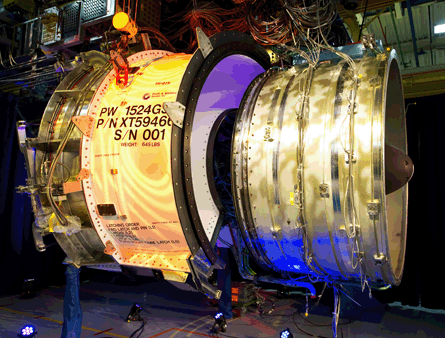The gas turbine engine has had a good run, but its days as propulsor of choice for the aviation industry may be numbered. Aircraft structures can become only so much lighter with composites, airflows can be made only so much smoother with winglets and laminar flow techniques.
Another answer to aviation's future may be a radical new twist on the Brayton cycle, or leaping to a different cycle altogether.
Brayton is the name given to the process of sucking air into a compressor, igniting it with fuel and then letting the heated exhaust escape.
That relatively straightforward process transformed aviation with the turbojet in the 1940s, then again with the arrival of the turbofan in the 1960s.
The next step-change improvement in turbofan efficiency could be its last, said Dale Carlson, jet engine manufacturer GE Aviation's executive for advanced systems, addressing the Future of Electric Flight Symposium on 29 July.
The best turbofans today make use of 40% of potential energy stored in the fuel, Carlson said.
 |
|---|
© Pratt & Whitney/Spencer Sloan |
A new generation of gas-powered turbofans in development - featuring variable bypass flows and ultra-high pressure ratios between the last compressor stage and the inlet - will at best convert between 55% and 70% of the fuel's energy into propulsion, he added.
GE and Rolls-Royce are under contract to design such an engine for the US Air Force, and the technology will likely transition to the commercial market.
That ultra-high pressure, variable-cycle engine will mark the peak of gas turbine efficiency, but if aircraft propulsion is to become even more efficient, the industry must move beyond gas-powered turbines.
Two of the options currently under investigation by GE are hybrid turboelectric systems and pulse detonation engines, Carlson said.
The hybrid turboelectric concept uses gas-powered generators to supply electricity to motors, driving fans that produce thrust.
Pulse detonation produces thrust by igniting a mixture of fuel and oxygen inside an open-ended tube.
Both concepts have certain merits. The hybrid turboelectric system allows airframe designers to distribute propulsors more aerodynamically, rather than concentrate thrust-producing engines in drag-heavy pods.
Pulse detonation eliminates all moving parts from the propulsion process.
At the same time, neither concept is ready to be adopted soon.
Harnessing the full potential of hybrid systems may require shifting to unconventional airframe designs, such as blended wing bodies. Distributed propulsion is also heavier than gas turbines. Pulse detonation produces supersonic shockwaves that are both noisy and damaging.
Still, GE is continuing studies on both kinds of next-generation propulsion systems, Carlson said.
NASA is sponsoring early research and development of commercial blended wing body airframe designs that include hybrid electric propulsion.
Meanwhile, the Defense Advanced Research Projects Agency (DARPA) is funding GE to develop Vulcan - a combination turbojet and pulse detonation engine for high-speed military aircraft.
Three years ago, the USAF also experimented with a pulse detonation engine installed aboard a Long E-Z single-seater.
Perhaps more interesting are the propulsion concepts left out of Carlson's presentation .
Notably, among the concepts excluded was an all-electric large commercial aircraft.
In general aviation, electric power is starting to gain traction as an alternative to the piston engine.
Start-up companies, such as China's Yuneec and Germany's PC-Aero, and even established manufacturers including Cessna, EADS and Sikorsky, are producing or at least experimenting with electric-powered aircraft.
So far, however, the challenges of electric power remain beyond the technology horizon for large commercial aircraft applications, such as a next-generation narrowbody.
The most powerful electrical storage devices currently on the market - lithium-ion batteries - generate only about 0.15kWh/kg of specific energy, Carlson said.
The next generation of lithium polymer batteries are in early development, but will at best generate 0.45kWh/kg of specific energy, he added.
A large commercial aircraft will require much more powerful batteries, generating at least 0.6kWh/kg.
For the foreseeable future, batteries will be too heavy anyway. GE has estimated that an all-electric aircraft would require a propulsion system weighing 32,658kg (72,000lb).
A pair of gas turbines powering the same aircraft would weigh only 10,433kg, Carlson concluded.
Source: Flight International























